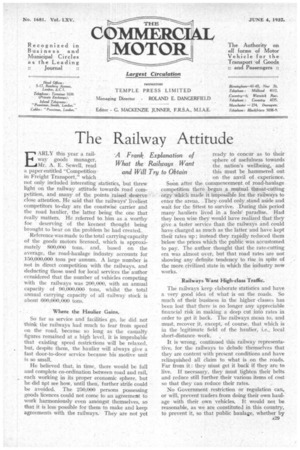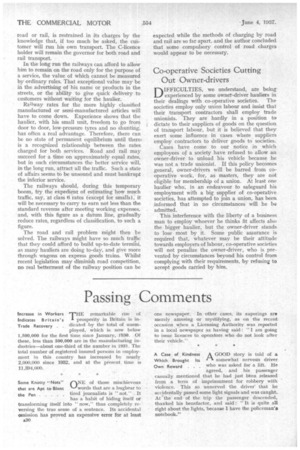The Railway Attitude
Page 31

Page 32

If you've noticed an error in this article please click here to report it so we can fix it.
EARLY this year a railway goods manager, Mr. A. E. Sewell, read a paper entitled "Competition in Freight Transport," which not only included interesting statistics, but threw light on the railway attitude towards road competition, and many of the points .raised deserve close attention. He said that the railways liveliest competitors to-day are the coastwise carrier and the road haulier, the latter being the one that really matters. He referred to himas .a worthy foe deserving of the keenest thought being brought to bear on the problem he had created.... Reference was made to the total carrying capacity of the goods motors licensed, which is approximately 800,000 tons, and, based on the average, the road-haulage industry accounts for 150,000.000 tons per annum. A large number is not in direct competition. with the railways, and deducting those used for local services the' author considered that the number of vehicles competing with the railways was 200,000, with an annual capacity of 90,000,000 tons, whilst the total annual carrying capacity of all 'railway stock is about 600,000,000 tons.
Where the Haulier Gains.
So fax as service and facilities go, he did not think the railways had much to fear from speed on the road, because so long as the casualty figures remained at a high level, it is improbable that existing speed restrictions will be relaxed, but, despite them, the haulier will always give a fast door-to-door service because his motive unit is so small.
He believed that, in time, there would be full and complete co-ordination between road and rail, each working in its proper economic sphere. but he did npt see how, until then, further strife could be avoided. The 250,000 persons possessing goods licences could not come to an agreement to work harmoniously even amongst themselves, so that it is less possible for them to make and keep agreements with the railways. They are not yet .A Frank Explanation of ready to concur as to their sphere of usefulness towards the nation's wellbeing, and this must be hammerea out on the anvil of experience.
• Soon after the commencement. of road-haulage competition there began a mutual throat cutting • orgy'which made it impossible for the railways to enter the arena. They could only stand aside and wait for the fittest to survive. During this period many hauliers lived in .a fools' paradise. Had they been wise they would have realized that they give a faster service than the railwaYs and could have charged as much as the latter. and have kept theii rates up ; instead they rapidly reduced them below the prices which the public was accustomed to pay. The author thought that the rate-cutting era was almost over, but that road rates axe not showing any definite tendency to rise in spite of the more civilized state in which the industry now works.
Railways Want High-class Traffic.
The railways keep elaborate statistics and have a very good idea of what is on the roads. So much of their business in the higher classes has been lost that there is no longer any appreciable financial risk in making a deep cut into rates in order to get it back. The railways mean to, and must, recover it, except, of course, that which is in the legitimate field of the haulier, i.e., local short-distance work.
It is wrong, continued this railway representative, for the railways to delude themselves that they are content with present conditions and have relinquished all claim to what is on the roads. Far from it : they must get• it back if they are to live. If necessary, they Must tighten their belts and reduce still further their various items of cost so that they can reduce their rates.
No Government restriction or regulation can, or will, prevent traders from doing their own haulage with their own vehicles. It would not be reasonable, as we are constituted in this country, to prevent it, so that public haulage, whether by road or rail, is restrained in its charges by the knowledge that, if too much be asked, the cuStomer will run his own transport. The C-licence holder will remain the governor for both road and rail transport.
In the long run the railways can afford to allow him to remain on the road only for the purpose of a service, the value of which cannot be measured by ordinary rules. That exceptional value may be in the advertising of his name or products in the streets, or the ability to give quick delivery to customers without waiting for the haulier.
Railway rates for the more highly classified manufactured or semi-manufactured articles will have to come down. Experience shows that the haulier, with his small unit, freedom to go from door to door, low-pressure tyres and no shunting, has often a real advantage. Therefore, there can be no state of permanent equilibrium until there: is a recognized relationship between the rates charged for both services. Road and rail may succeed for a time on approximately equal rates, but in such circumstances the better service will, in the long run, attract all the traffic. Such a state of affairs seems to be unsound and must bankrupt the inferior service.
The railways should, during this temporary boom, try the expedient of estimating how much traffic, say, at class ti rates (except for smalls), it will be necessary to carry to earn not less than the standard revenue after meeting working expenses, and, with this figure as a datum line, gradually reduce rates, regardless of classification, to such a figure.
The road and rail problem might then be solved. The railways might have so much traffic that they could afford to build up-to-date termini, as many hauliers are doing to-day, and give more through wagons on express goods trains. Whilst recent legislation may diminish road competition, no real betterment of the railway position can be expected while the methods of charging by road and rail are so far apart, and the author concluded that some compulsory control of road charges would appear to be necessary.
Co-operative Societies Cutting Out Owner-drivers
DI FFI C ULT IES , we understand, are being experienced by some ownet-driver hauliers in their dealings with co-operative societies. The societies employ only union labour and insist that their transport contractors shall employ trade unionists. They are hardly in a position to dictate to their suppliers of goods on the question of transport labour, but it is believed that they exert some influence in cases where suppliers employ contractors to deliver goods to societies. Cases have come to our notice in which employees of a society have refused to allow an owner-driver to unload his vehicle because he was not a trade unionist. If this policy becomes general, owner-drivers will be barred from cooperative work, for, as masters, they are not eligible for membership of a union. At least one haulier who; in an endeavour to safeguard his employment with a big supplier of co-operative societies, has attempted to join a union, has been informed that in no circumstances will he bo admitted.
This interference with the liberty of a business man to employ whoever he thinks fit affects also the bigger haulier, but the owner-driver stands to lose most by it. Some public assurance is required that, whatever may be their attitude towards employers of labour, co-operative societies will not penalize the owner-driver, who is prevented by circumstances beyond his control from complying with their requirements, by refusing to accept goods carried by him,




























































































